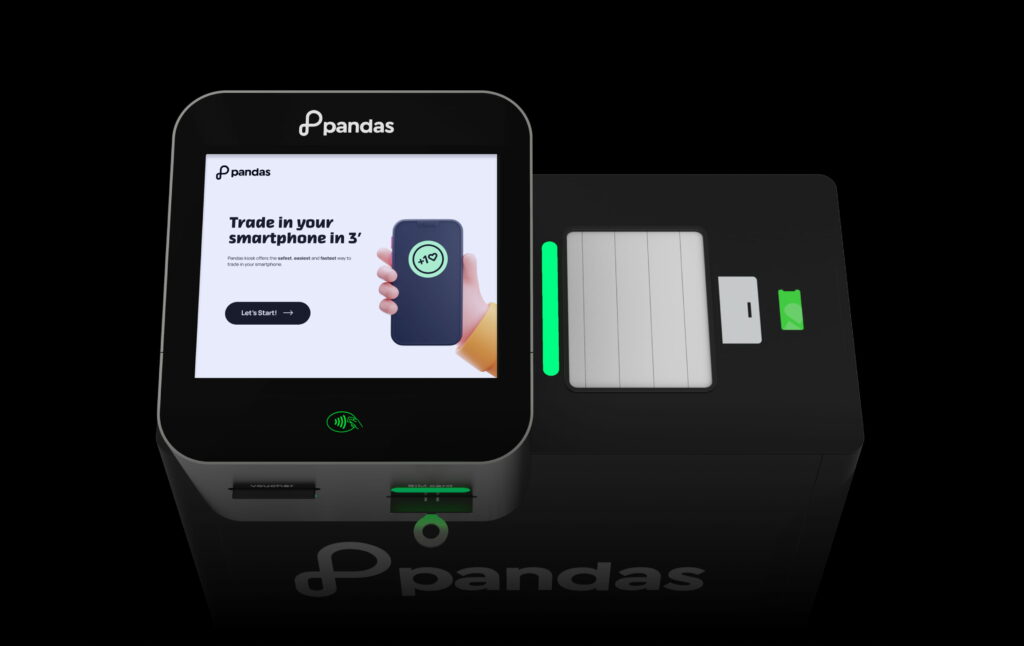Pandas was formed to solve a very specific problem.
Current trade-in solutions are slow, opaque, and very complicated – at times, taking even up to three weeks for a customer to sell their device and get paid for it.
So we set out to find a better, much faster, and more efficient alternative. We thought that if today’s technology allows you to buy a new smartphone in a few minutes, you should also be able to trade it in, in the same amount of time. Sounds impossible? How can you streamline a process that takes weeks to a matter of minutes?
Well… We do like a challenge!
After dozens of prototypes, the Pandas Robot AI Box was born. And it works wonders: it’s autonomous, accurate, can wirelessly connect to devices and – hear us out – in less than 3 minutes, it can evaluate a smartphone and make an offer to the customer. Awesome, huh?
We’d like to think it’s the perfect machine that buys phones but don’t take it just from us. We’re very proud to be rated 4.7/5 from our customers for our overall services. But we’re not here to brag. The trade-in market needs to change!
In this post, we’re sharing 5 key takeaways from our design process into the robot machine and our experience in operating it. Let’s start
1. A robot that is autonomous allows for maximum ease and versatility in running a trade-in program.
The problem:
For starters, a big issue are the gaps that inevitably exist in a manual process that requires a lot of back and forth among staff, stores, and warehouses. The device needs to go through many “check-points” (with manual evaluations, cables, and other physical tools) in order to be graded. Each check-point not only breaks up the process but also isn’t 100% accurate since it relies on the human factor. Employees may have blind spots and are bound to bring a level of subjectivity in a task that has to be as objective as possible.
Our solution:
So very early on, we understood how important it would be to have an autonomous trade-in system for wireless identification that doesn’t require cables or manual inputs. We also searched for the latest technological advancements in regards to evaluating the condition of electronic devices and had to even develop our own, custom AI to be able to grade each smartphone. The latest version of our Robot AI Box can now perform wireless identifications and evaluations, without the need for the in-store staff members. All the user has to do is just insert their device into the machine’s drawer and the magic happens automatically in less than 3’. Thinking of practicalities too, it’s also plug-and-play – it can be deployed easily in a store within 20 minutes.
2. Efficiency in your trade-in program means that you should be able to grade fast and at scale. Again, and again, and again.
The problem:
Stores that want to do grading fast and at scale need small machines that can fit their stores, as retail space is usually limited and must be utilized as efficiently as possible. Moreover, they want units of economics to make sense for them. Or in other words, to pay a reasonable price for the trade-in technology they’re incorporating. This isn’t the case with already existing machines, which are big, bulky, and too expensive to be produced.
Our solution:
Our Robot AI Box has a size that fits perfectly even to small to medium stores, not just large ones. Additionally, the way it’s built, it allows for storage of multiple devices that have been sold, tracking each and every one of them separately. And we didn’t stop there. Our robot can go into production at large, without problems in the supply chain and most importantly, without the exuberant costs other machines require.
3. Your entire trade-in program relies on one thing: how good you are in a battle with time.
The problem(s):




Our solution:
We automated it, we made it efficient and then we had to make it fast. Blazing-fast. First, by deploying technology that collects all necessary information about the device itself via a wireless handshake, double-checking with international databases that it’s not stolen or missing. Secondly, creating special 4K camera systems that perform a 360-degree scan of the device to check its aesthetic condition for even the faintest scratches, breaks and tears to the body. And thirdly, by developing a special software that automatically checks all the components of the smartphone (such as microphones, cameras, touch functionalities, etc) to evaluate their condition. By combining all 3, we made a special system for labeling the condition of the device from Faulty to Like New. We then instruct our AI to make an offer according to the designated label. It all takes less than 3 minutes to happen. Yeah, it’s very cool.
4. You can have the best technology in the world but if your customer cannot interact naturally with it, well… it’s not the best yet.
The problem:
Yes, we can talk about infrared cameras and wireless grading systems all we want but having the user at the center of this conversation is crucial. Your beloved grandma and grandpa should be able to easily interact with your product, without any assistance. It has to be easy for everyone.
Our solution:
Quite frankly, the user probably isn’t very interested to learn about your technological advancements. If they want to, sure, go ahead, but at the end of the day, they just want it to work easily, without hiccups. That’s when UI/UX comes into play. We thought long and hard about the interface, our window to the real world, and realized it needed to be as simple as possible. Do you want to trade in your smartphone? Simply place it in the robot’s drawer, follow some instructions in a very clear process, and wait a couple of minutes until you get an offer. If the offer is satisfactory, you can simply scan your debit card to receive a cash deposit or opt for a store voucher. It’s seamless, frictionless, no cables required, no go-through-countless-screens required. We’ll do the heavy work for you.
5. Grading is a fine science that needs to be translated into the most accurate system that never fails.
The problem:
Every smartphone that goes through a trade-in program is unique, with a unique set of issues, scratches, bumps and tears that you need to take into account when evaluating each device before you make an offer. It needs to be simplified, otherwise you can end up with discrepancies for the offers you make to each user, and a patchy pricing strategy that can be detrimental to your business.
Our solution:
Our robot operates with a custom system that streamlines all evaluations and increases accuracy to the max. Based on a model we created to grade each smartphone we receive, it automatically matches it with our database. That database is dynamic and synced with the biggest marketplaces to check the device’s demand and update its pricing based on it. This way, we can always offer an accurate price to buy the user’s phone that is fair and calculated accurately.
TL;DR?





These are your 5 north stars when it comes to not just making a machine that buys phones but also streamlining your trade-in program overall.
If you can have all of them, it’s a recipe for success. If you want to learn more about the Pandas Robot AI Box and how it can transform your business too, get in touch!




